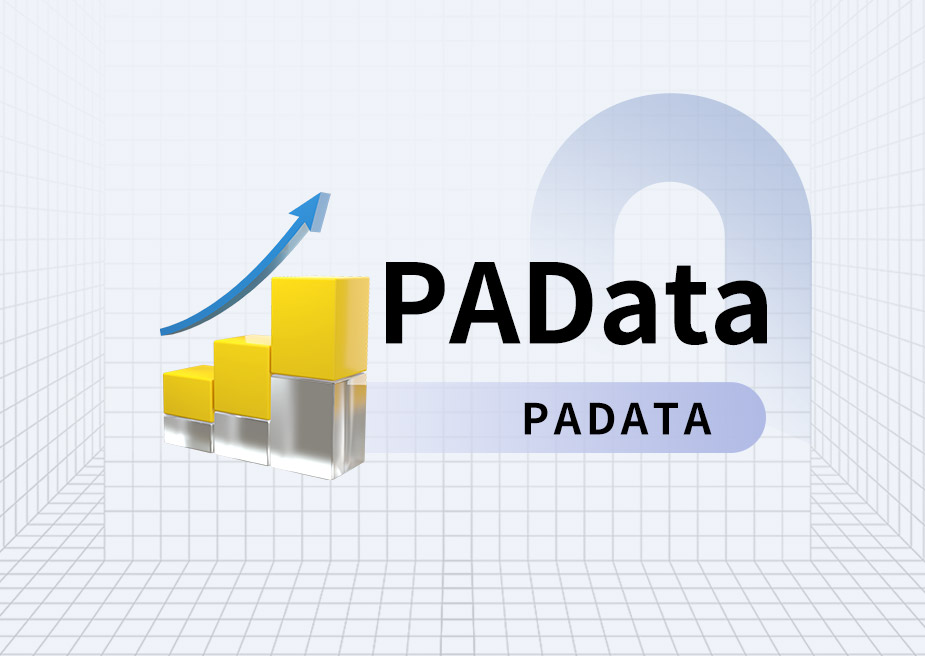Written by Deng Tong, Jinse Finance
The cryptocurrency market has been sluggish recently, and since the "October 11 crash," cryptocurrencies such as BTC have failed to recover their losses. As of press time, BTC is trading at $109,279, a 13.33% drop from its monthly high of $126,080 on October 7.
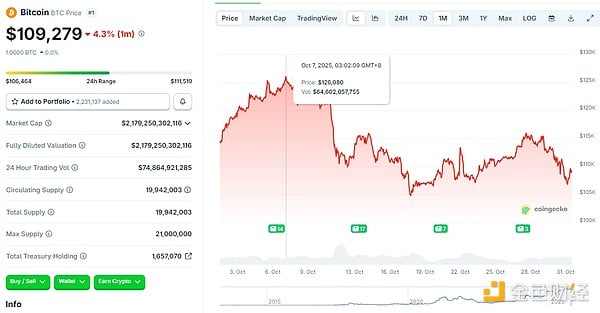
Meanwhile, DAT (Digital Asset Treasury), which once garnered significant attention due to the bullish crypto market, has suddenly cooled off due to market fluctuations. This article focuses on the current situation of those once-popular DATs, discusses the voices supporting and opposing DATs, and explores their future prospects.
I. Current Status of Leading DAT Companies
Since the DAT craze began, companies from all walks of life have turned to crypto treasury reserves. Unsurprisingly, every company that made the transition experienced a brief surge in stock price after announcing the news, after which most of the companies' stock prices fell back to their previous levels.
1. Strategy
Strategy is one of the most prominent DAT (Data Analytics, Reporting, and Information) companies in the industry. Prior to August 2020, Strategy was a giant in traditional business intelligence software, providing enterprise clients with data analytics, report generation, and visualization platforms. Its business model was that of a typical B2B software company, relying on software sales, licensing, and subscription services for revenue. Strategy's stock price had long fluctuated between $120 and $140.
After transforming into a DAT company, the company's core strategy shifted from intelligent software to the operation and management of Bitcoin treasury. While continuously buying BTC, it also strengthened its treasury strategy by issuing bonds and other means.
Currently, Strategy holds 640,808 BTC, worth $70.24 billion, representing 3.051% of the 21 million BTC in circulation.
On October 30th, Strategy's total assets surpassed those of fast-food giant McDonald's; on October 29th, Swiss National Bank disclosed holding $213 million worth of shares in the Bitcoin treasury company Strategy, with assets under management reportedly reaching $10.5 trillion. However, even with such positive news, Strategy's stock price performance remains below its former peak.
Last November, Strategy's stock price reached a high of $473.83. On October 6th of this year, its stock price reached a monthly high of $359.69, but with the October 11th crash that decimated the cryptocurrency market, Strategy's stock price also continued to decline, currently trading at $254.57, a 29.23% drop from its monthly high.
As a result, Strategy's stock price has recently followed a similar trend to BTC, rising and falling in tandem. However, its stock price has corrected by nearly 30%, a drop far greater than BTC's approximately 13%, and its volatility is more than double that of BTC.
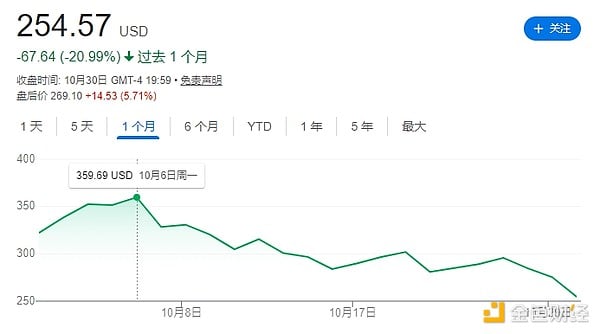
2. Marathon Digital Holdings Inc.
Marathon Digital Holdings Inc., formerly known as Marathon Patent Group, primarily acquires and manages various patents, generating revenue through licensing and litigation. After transforming itself in 2020, it became a Bitcoin mining company, focusing entirely on building mining farms, deploying mining rigs, increasing computing power, and earning Bitcoin block rewards. This makes it an infrastructure provider for the Bitcoin network, and the company's revenue is directly linked to the price of Bitcoin and its computing power.
Through its transformation, Marathon rose from an obscure micro-cap company to a Nasdaq star stock and industry giant, gaining unprecedented market attention and financing capabilities. Furthermore, before the Bitcoin mining industry was completely monopolized by giants, it rapidly seized market share through aggressive capital operations, establishing its leading position in the mining sector.
Currently, Marathon holds 52,850 BTC, worth $579 million, representing 0.252% of the 21 million BTC in circulation.
During the 2021 bull market, Marathon's stock price climbed to a high of nearly $80 before gradually declining, fluctuating around $20 for most of the time. On October 15th, MARA reached a monthly high of $22.84, but with the recent overall slump in the crypto market, MARA is currently trading at $17.76, a 22.24% drop from its monthly high. This decline is also greater than the 13% correction seen in Bitcoin.
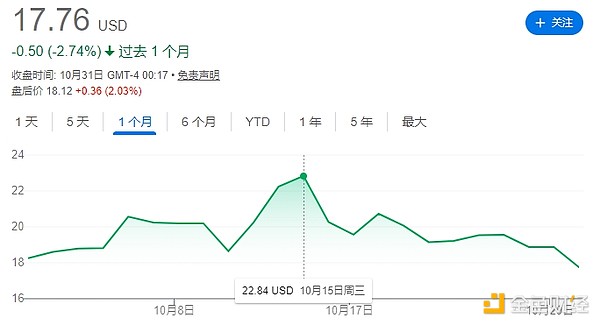
3. Metaplanet Inc.
Metaplanet has been dubbed the "Japanese version of 'Strategy'". Prior to its transformation, Metaplanet's core business was hotel services and management, primarily targeting domestic Japanese tourists. On May 13, 2024, Metaplanet announced a strategic shift in its financial management, designating Bitcoin as a strategic reserve asset to address ongoing economic pressures in Japan, particularly high levels of government debt, persistently negative real interest rates, and the resulting weakness of the yen.
Following its transformation, Metaplanet, like Strategy, converted its corporate assets from the depreciating Japanese yen (affected by Japan's ultra-low interest rates and currency devaluation) into Bitcoin as a store of value to hedge against inflation and currency devaluation. Bitcoin became the largest and most important asset on Metaplanet's balance sheet.
Currently, Metaplanet holds 20,136 BTC, worth $221 million, representing 0.096% of the 21 million BTC in circulation.
In June of this year, Metaplanet's stock price rose to a high of 1,895 yen before declining steadily. On October 7th, Metaplanet's stock price reached a monthly high of 624 yen, after which it mainly trended downwards, currently trading at 491 yen, a 21.31% drop from its monthly high. This decline is also greater than the 13% correction seen in Bitcoin.
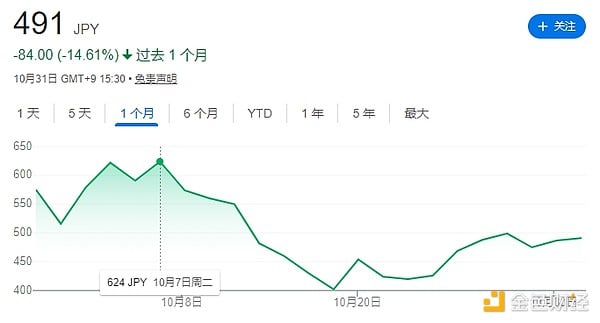
4. Coinbase Global, Inc.
On April 14, 2021, Coinbase went public, a listing widely regarded as a milestone for the cryptocurrency industry, marking a key step for the industry into the mainstream financial world.
Currently, Coinbase holds 11,776 BTC, worth $129 million, representing 0.056% of the 21 million BTC in circulation.
Since Coinbase is not involved in the business transformation from traditional industries to the crypto industry, its stock price has the clearest relationship with crypto bull and bear markets.
In November 2021, Bitcoin (BTC) reached a new high of nearly $70,000, and the crypto market was booming. Coin (COIN) also reached a high of $357, attracting widespread attention. However, in 2022, the crypto industry was hit by a series of negative events, such as the collapse of Luna and the bankruptcy of FTX, ushering in a crypto winter. Coin's price subsequently fell below $50, and its stock price remained sluggish in 2023, hovering below $100. In 2024, due to a shift in US regulatory policy, the SEC approved several Bitcoin spot ETFs, and Coinbase was selected as the Bitcoin custodian for the vast majority of these ETFs, greatly boosting Coin's stock price. This July, Coin climbed to a high of $419.78.

On October 8, COIN reached a monthly high of $387.27, but after the crash on October 11, COIN also fell, and as of press time, it was trading at $328.51, down 15.17% from the monthly high, which is similar to the 13% drop in BTC.
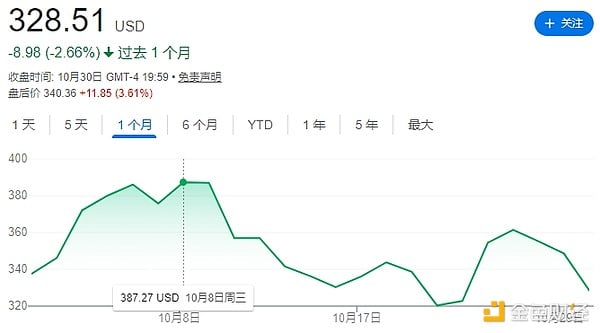
II. Analysis of the Relationship between DAT Company's Stock Price and BTC Price
In the short term, regardless of the price of BTC at the time, as long as a company announces a transformation, its stock price will generally see an upward trend. However, the stock price after the transformation is greatly affected by the cryptocurrency market. For example, the three companies mentioned above faced the crash of October 11, and the decline in their stock prices from their peak to the present is greater than the decline in BTC.
In the long term, taking Coinbase as an example: since Coinbase's IPO in 2021, COIN's stock price has shown a strong correlation with the shifts between bull and bear markets in the crypto market. During bull markets, COIN's price is at a high level, while during bear markets, COIN consistently hovers at a low point.
Therefore, DAT's fate is deeply intertwined with Bitcoin's bull and bear markets. When the crypto market is booming, it can soar along with the crypto market, but when the market is down, it will face the double squeeze of falling cryptocurrency prices and rigid operating costs, potentially leading to huge losses and a sharp drop in stock price.
III. The Debate on DAT: A Double-Edged Sword
In a Forbes article, Coinfund President Chris Perkins declared that the summer of 2025 would be "an unforgettable summer of DAT." Indeed, the summer of 2025 saw numerous announcements from traditional companies about launching crypto treasury reserves, but the debate surrounding DAT never ceased.
Compared to traditional company investments, DAT has its unique advantages: it is both a publicly traded company and a capital market instrument, allowing direct investment in specific digital assets. For investors, this offers a highly attractive alternative, eliminating the need to directly hold the asset or through an exchange-traded fund. Investing in DAT is seen as a high-beta, high-leverage investment approach, enabling investors to gain greater exposure through a familiar equity structure.
This model is built on a "positive feedback loop" that can lead to rapid wealth growth when conditions are favorable. When crypto asset prices rise, the equity value of DAT typically trades at a significant premium to its net asset value (NAV). This premium allows the company to raise new capital by issuing shares at a price higher than NAV, a process usually achieved through market-to-market (ATM) offerings. The funds raised from these share issuances are then used to purchase more digital assets, thereby increasing the asset value per share for existing investors. This positive feedback loop can be a powerful growth engine, but it is also fragile and highly dependent on market sentiment and a sustained upward trend in asset prices.
Investors who are optimistic about DAT believe that DAT still has great potential for future growth.
First, regulatory transparency is steadily improving. Institutional confidence is growing as governments around the world, including the United States, develop more standardized frameworks for digital assets. At the same time, regulators are gradually moving away from a cautious approach and actively exploring how to integrate digital assets into the existing financial system, thereby creating a more predictable environment for business operations and investor participation.
Secondly, the widespread shift of institutional investors towards digital assets is undeniable. A 2025 survey of institutional investors by Ernst & Young showed that the vast majority of institutional investors expect to increase their allocation to digital assets, with the primary goal of portfolio diversification.
Finally, the unique advantages of digital assets—such as faster settlement speeds, lower financing costs, and greater transparency—make them an ideal choice for corporate finance executives to optimize cash management and unlock value beyond traditional financial instruments.
Critics argue that DAT carries significant risks: a reflexive cycle driven by trading premiums. The model works well when the market is in a sustained uptrend, but it quickly fails once market sentiment reverses. A sharp drop in premiums can trigger a negative feedback loop, making it difficult for companies to raise capital without significantly diluting equity or taking on high-cost debt.
For struggling companies, becoming a DAT (Digital Asset Tax) is a way to rebrand, capitalize on the growing cryptocurrency market, and raise new funds. However, many DAT companies lacking significant operating revenue rely heavily on capital market financing. The ability to repay or refinance these debts becomes a major concern when the market downturns. Furthermore, an overemphasis on asset appreciation can cause investors and management to overlook the hidden costs of holding these assets. In addition to initial capital investment, there are ongoing expenses such as custody, security, compliance, and risk management. Like any financial market, the digital asset market is volatile, thus requiring robust risk frameworks, sound governance, and excellent operations to protect against fraud and cyber threats.
IV. The Future of DAT
BitMine Chairman Tom Lee has pointed out that as more and more DAT enters the public market, many DATs are trading below their net asset value, which is the value of their underlying cryptocurrency holdings. "If this isn't a bursting bubble, then how is it?" he asked.
In a report, David Duong, Head of Investment Research at Coinbase, and Colin Basco, a researcher at Coinbase, pointed out that publicly traded companies buying cryptocurrencies are entering a "player-versus-player" phase, with companies fiercely competing for investor funds, which could drive up cryptocurrency market prices. "The days of easy money and guaranteed mNAV (net asset value multiple) premiums are over."
Early entrants like large Bitcoin holding companies like Strategy “enjoyed a considerable premium,” but “competition, execution risk, and regulatory constraints led to a compression of mNAV.” “The scarcity premium enjoyed by early adopters has disappeared,” and the cryptocurrency asset has now “reached a critical inflection point.” In today’s highly competitive market environment, the success of finance firms “increasingly depends on execution, differentiation, and timing, rather than simply replicating Strategy’s strategy.”
After the fierce competition, the DAT companies that survive are likely to be those that can demonstrate a clear and robust business model, rather than those that rely solely on market sentiment and leverage.




